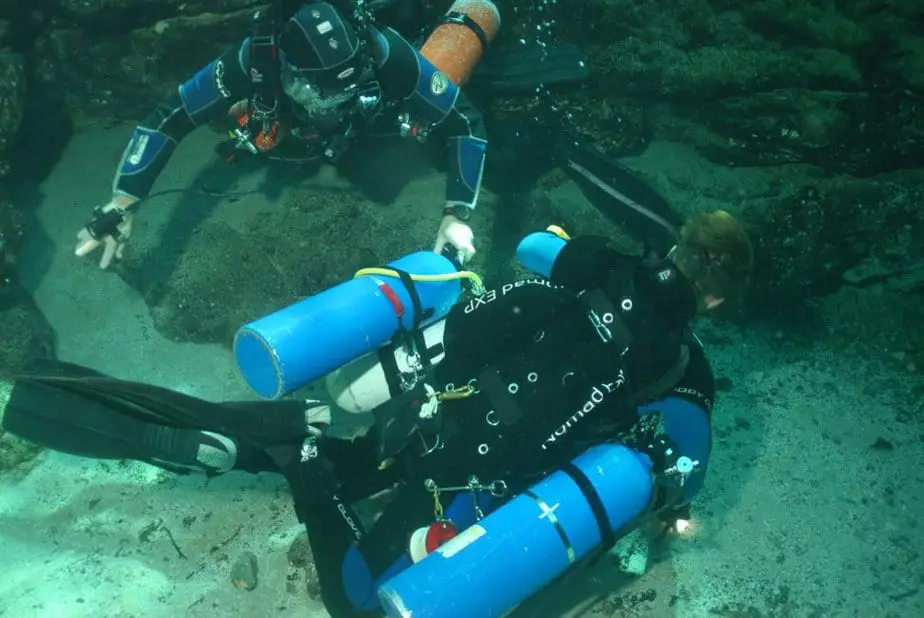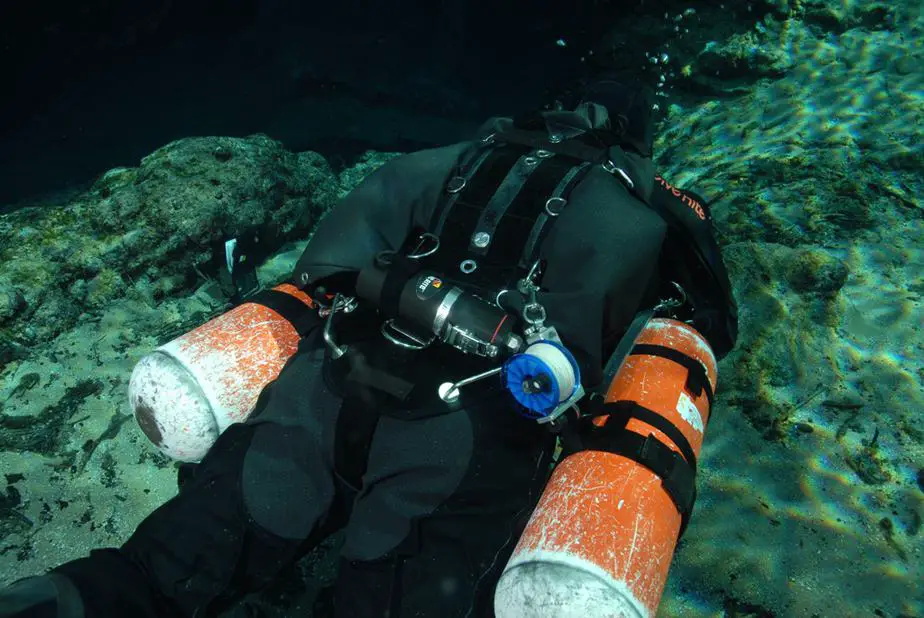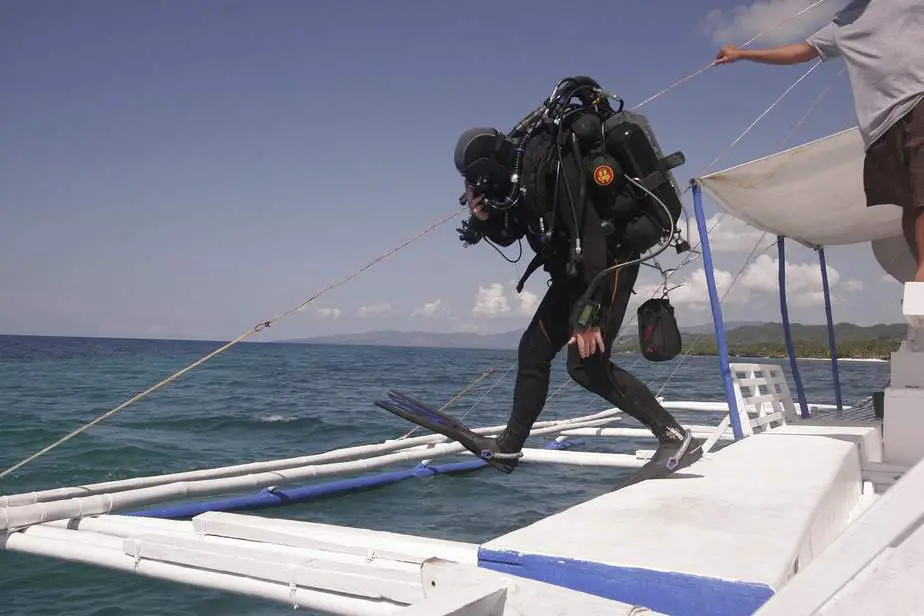If you want to dive deeper than ever before, you need to learn about trimix diving. This type of diving is not for beginners. When diving trimix, you will use a gas blend that contains three different gases. Trimix is frequently used in technical diving by commercial or technical divers to avoid most of the problems with breathing compressed air. In this article, we’ll discuss more about trimix diving, how it works, and why you need it to dive as deep as possible.
What is trimix diving?
Trimix diving refers to the use of three gases, the trimix gas, to help scuba divers dive deeper with less of a chance of suffering any negative effects from breathing compressed air. The breathing gas used is a combination of helium, oxygen, and nitrogen in various blends depending on the situation, however a common blend is 21% oxygen, 35% helium, and 44% nitrogen.
Trimix is commonly used for deep diving and is often used by technical divers. As your diving skills improve and you accumulate more certifications, you will most likely come across trimix diving. Technically, trimix refers to any three gases in a mix, however for scuba diving purposes, only the three aforementioned gases are used.
With trimix, a diver can dive as deep as 90 m (300 ft) underwater or even deeper. It requires significant technical diving training, including a Tec Trimix certification. You also have to make sure that your gear can handle trimix diving. Most recreational gear can support nitrox diving, however you’ll probably need at least a new dive computer for trimix diving.
Trimix gas blends
Depending on how deep you plan on diving, the trimix blend will vary from the usual predetermined amount. For instance, if the planned depth is 70 m (240 ft), the trimix may be expressed as 17/50. You’ll notice there are only 2 numbers, so some quick mental math is needed to total 100%.
This trimix blend has 17% oxygen, 50% helium, and 33% nitrogen. Whenever you see a trimix blend expressed this way, the first number is the percentage of oxygen, the second is the percentage of helium, and the percentage of nitrogen is the remaining amount out of 100%.
Most mixes are Normoxic Trimix, which means that the blend contains around 21% oxygen (no less than 18%) and varying levels of helium and nitrogen. Normoxic trimix is commonly used for deep dives down to around 65 m (200 ft).
For any dives exceeding that depth, Hypoxic Trimix is used. This is a blend that has oxygen content less than 18%.
As you’ll recall, when breathing standard air, the percentage of oxygen in the mix is 21% and nitrogen is 78%, with various other gases making up the remaining 1%. Diving enriched air nitrox is when the oxygen percentage is greater than 21%, and therefore nitrogen is less than 78%. With trimix, helium is added into the mix.
If you plan on diving deeper, then the amount of oxygen and nitrogen needs to be decreased in favor of adding more helium into the mix. Helium prevents oxygen toxicity and nitrogen narcosis, two common problems that prevent recreational divers from diving deeper.
Why you need trimix for deep diving

In this section, we’ll discuss why you can’t just breathe standard air when diving deep, and why trimix is the optimal gas mix to safely do so. You’ll have learned about Boyle’s law and how it affects scuba diving in your Open Water Diver course. Simply put, the deeper you dive, the more the water pressure compresses the gases in your scuba cylinder and lungs, decreasing their volume.
When you are breathing compressed air, more of it can enter your bloodstream, and this results in some unfavorable outcomes. For one, when too much nitrogen enters your tissues, you can potentially suffer from nitrogen narcosis. The effects of nitrogen narcosis are somewhat similar to being drunk. You will not be in the right state of mind and will exercise poor judgment.
Furthermore, when too much nitrogen is in your system, it puts you at increased risk of decompression sickness when you ascend. Diving nitrox is a way to help reduce the amount of nitrogen that enters your system by adding in more oxygen (greater than 21%) to the mix relative to standard air. This means that the percentage of nitrogen is decreased, so you’re breathing less nitrogen overall
However, now you are at greater risk of another issue: oxygen toxicity. When you breathe in too much oxygen, you can experience blurred vision, nausea, chest pain, convulsions, difficulty breathing, and even death.
In order to avoid nitrogen narcosis and oxygen toxicity, a third gas is introduced into the mix: helium. With helium in the picture, the amount of oxygen and nitrogen content in the mix is reduced, so trimix divers are at a lower risk of experiencing both of the aforementioned issues. This also has the added benefit of letting divers dive even deeper than ever before.
Why use helium for breathing?
Oxygen and nitrogen are naturally found in standard air, and the same gases are used in different percentages when diving nitrox, so why was helium chosen as the third gas for trimix? First, helium has a low density which makes it easier to inhale at extreme depths.
Two, helium has smaller bubbles than nitrogen, and diffusion of helium in tissues and blood is significantly easier and faster compared to other gases, which decreases the risk of decompression sickness (the bends). Third, helium is non-reactive with other chemicals and four, it is less narcotic than nitrogen.
In fact, some divers even report that they feel better after diving with trimix compared to standard air or nitrox, though their claims have not been empirically tested. With that said, helium is quite expensive and requires additional training to be safely used, which is why trimix is almost exclusively used by professional or technical divers. Furthermore, recreational divers are unlikely to dive to the depths necessary for using trimix.
Downsides to trimix diving
It seems like helium is a cure-all for any issues relating to nitrogen narcosis and oxygen toxicity, so why aren’t all tanks filled with helium? Why isn’t trimix the standard breathing gas for all scuba cylinders?
The first reason is a financial one: helium isn’t cheap. It’s a scarce gas which drives up its price, and it even requires additional training which is yet another steep cost. And yes, training is required. Decompression when diving trimix is different from other gas mixtures, so divers need the proper training in order to avoid decompression sickness.
Another downside to diving trimix is that it decreases core body temperature and makes divers susceptible to High-Pressure Nervous System or HPNS for short. Colloquially known as helium tremors, this condition can occur for dives exceeding 600 fsw (foot sea water). Its symptoms are nausea, fatigue, shaking, and cognitive impairment. While uncommon, researchers still warn about the risks of using helium.
Despite the drawbacks, helium is still considered safe overall and the best gas blend for diving deeper. There is a myth that nitrox can help you dive deeper, however it’s more accurate to say nitrox helps you dive for longer. If you want to dive deeper, learn how to dive trimix.
How can I learn about trimix diving?

Trimix isn’t something you can just put in your tank and dive like normal with barely any consideration. There are various factors that go into finding the right gas blend, and you’ll need to take a Trimix Diving course to learn the fundamentals. You’ll need to have quite a bit of experience to even be eligible to take a trimix course. If you only have your Open Water Diver certification, you’ll need way more experience.
For the PADI Tec Trimix Diver certification, you’ll need to first take the PADI Tec 50 or the Tec Trimix 65 course. You’ll also need to have a minimum of 150 logged dives, be 18 years of age or older, and have a medical clearance signed by a doctor within the last 12 months.
In an advanced course like this, you’ll learn important skills like planning trimix mixtures for different depths, how to use decompression software with trimix, multi-gas dive computers, and handling multiple decompression cylinders.
The course will also teach you how to handle emergency situations, which becomes even more risky the deeper you dive. Keep in mind that diving to such depths requires much more planning upfront to ensure all divers remain safe. The initial trimix class teaches you how to dive to 65 m (210 ft), meaning there is still more to learn before you can dive to 90 m (300 ft).
If you can’t get enough of diving and want to dive as deep as you possibly can, then you will eventually have to learn about diving trimix. By getting trimix certified, you will have a solid theoretical base from which you plan your dives and make better decisions during the dive.
History of diving with trimix
As with many innovations, we can attribute the discovery of trimix to the military. During World War II, the US and British navy were experimenting with diving technology. The goal was to reach new depths so that they can retrieve sunken military equipment. They found that helium was effective in saturation diving for the reasons we discussed above.
The results of these studies were relatively unknown outside of the military until the 70s and 80s when helium mixtures began to be used by technical divers for cave diving. Another decade later, and trimix was starting to become standardized, with courses now being taught so that more of the public could learn it if they wanted. Now, trimix is much more accessible than the decades after WWII, though the niche is still quite small.
Today, trimix is often used on dives that exceed 45 m (150 ft). A trimix diver uses it to descend to that depth and even further with a lower risk of inert gas narcosis or oxygen toxicity.
Summary
To sum it all up, trimix diving refers to diving with a combination of three breathing gases – oxygen, nitrogen, and helium. It is used by technical divers to safely dive more than 45 m (150 ft). Technically, starting from 30 m (100 ft) onwards, some divers can already start to experience the effects of nitrogen narcosis. If your physiology is susceptible to it, then you may need to use trimix starting from that depth.
The deeper one dives underwater, the more pressure they are subjected to. The air in one’s lungs and scuba cylinder will also get drastically compressed, and breathing compressed air will cause more nitrogen to enter the bloodstream. By adding helium into the mix, the proportion of nitrogen in the gas mix is decreased, making it less likely for one to get nitrogen narcosis and decompression sickness.
That is trimix diving in a nutshell. Obviously, this article is just a starting point for you. If you really want to learn trimix diving, you’ll have to take the Tec Trimix Diver certification course to receive a proper education. So now that you know the basic concept, it’s time to put that theory into practice. Take a technical diver course and acquire the skills necessary to dive deeper than you’ve ever gone before.


